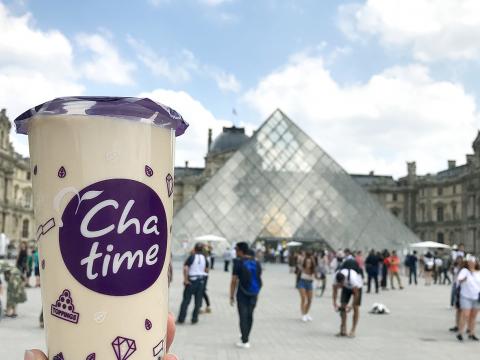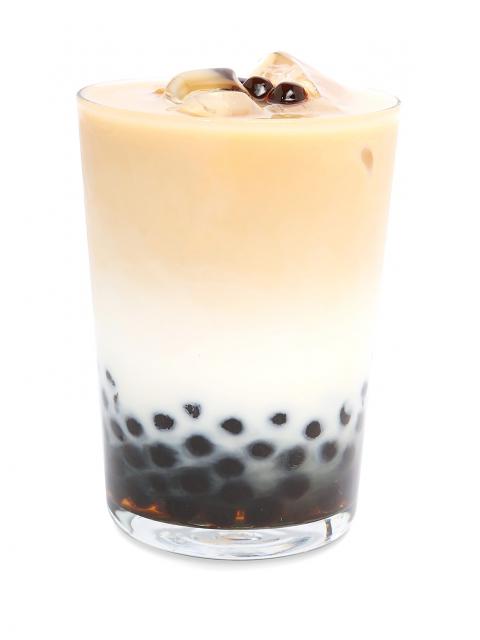Bubble tea, also called pearl tea (珍珠奶茶), is a quintessentially Taiwanese drink, but how old is the chewy tapioca ball-filled beverage, who invented it and how did it become to be so popular?
The origins of bubble tea are steeped in mystery and still hotly debated, but according to the orthodox version of events, the story begins in 1980s Taiwan.
At the time something called “bubble tea” — quite different from the drink we know today — was all the rage. Made with either black tea or green tea, brewed tea was sweetened with sugar syrup and then shaken through ice in a cocktail shaker to both chill the tea and produce a copious amount of bubbly froth at the top of the glass, similar to a “head” on a freshly poured pint of beer. The shaking was initially done by hand, but later machines were developed to automatically agitate the tea mixture.

Photo: Yang Ya-min, Taipei Times
At some point, chewy tapioca balls (粉圓) were added to bubble tea, resulting in pearl milk tea, the familiar drink we know today. Two rival Taiwanese teahouse chains — Hanlin Tea Room (翰林茶館) in Tainan and Chun Shui Tang (春水堂人文茶館) in Taichung — lay claim to conceiving the bubbly beverage.
DISPUTE OVER ORIGINS
Hanlin Tea Room insists it came up with the idea in 1986 when its founder Tu Tsung-ho (?宗和) spotted white-colored tapioca balls on sale at Tainan’s Yamuliao market. Tu had a sudden flash of inspiration and bought some of the balls home, and after cooking them through, added them to some milk tea. He found the texture pleasing and soon christened the new beverage pearl milk tea on account of the pearly, semi-translucent white tapioca balls. To this day, customers at any branch of Hanlin Tea Room can choose between either the original white tapioca balls or the more common black variety, made with brown sugar.

Photo Courtesy of Cha Cha The
However, Chun Shui Tang maintains it is the true inventor of the beverage, which it says was created by a then-20-year-old female employee, Lin Hsiu-hui (林秀慧), the following year in 1987. One day at the teahouse, Lin experimented by mixing her favorite childhood snack, tapioca balls, with iced milk tea and also lemon black tea to produce what the company claims was the world’s first cup of pearl milk tea.
The two companies became locked in a bitter dispute, filing lawsuits against each other and eventually going to court to settle the matter. However, since neither one was able to successfully patent or trademark their product, by the mid-1990s, pearl milk tea featured on the menus of Taiwan’s teahouses, which were popular hangouts for students and businessmen to relax and chew the cud in the days before the influx of coffee shops. With the introduction from abroad of machines that automatically seal the top of takeaway cups with a thin film of plastic, the modern takeaway version of the beverage was born.
ANOTHER THEORY
However, there is an intriguing alternative explanation: bubble tea’s earliest incarnation could in fact be traced back to the days of the British empire. In British Malaya (modern-day Singapore and Malaysia) an iced drink/desert, usually called cendol or chendol, began to be drunk to provide respite from the tropical heat.
Brightly-colored, worm-like gelatinous strands, usually made from rice flour or sago, are added to coconut milk which has been sweetened with sugar and combined with ice to make a refreshing drink or iced snack. It is thought that cendol may have been inspired by locals observing British expatriates adding milk to their tea and may have originated in port cities such as Malacca or Penang, where refrigeration technology from British ships would have provided the ice. Today, Cendol is a ubiquitous thirst-quencher drunk across South East Asia, including Thailand, Vietnam and Indonesia and when served in a tall glass, bears an uncanny resemblance to Taiwan’s bubble tea.
Meanwhile, chewy tapioca balls, called fenyuan in Chinese, somehow made their way to Taiwan from abroad — possibly via China, after being presented to Empress Dowager Cixi (慈禧太后) as tribute — and began to be used as an ingredient in sweet snacks at Taiwanese night markets. Contrary to the competing claims of the teahouses, perhaps the real origin of bubble tea is to be found in Taiwan’s night markets, possibly inspired by a Taiwanese night market vendor sipping on a glass of cendol during a trip to Singapore or Malaysia.
Whatever the true origin of bubble tea, today takeaway tea shops abound on almost every street corner and rival chains fiercely compete for business, continually innovating wacky new flavor combinations and textures to keep customers coming back for more. In recent years, Taiwan’s quasi-national beverage has successfully seen off the coffee juggernaut as well as multiple food safety scares and looks set to stay a permanent fixture of Taiwan’s culinary scene for many years to come.

On April 26, The Lancet published a letter from two doctors at Taichung-based China Medical University Hospital (CMUH) warning that “Taiwan’s Health Care System is on the Brink of Collapse.” The authors said that “Years of policy inaction and mismanagement of resources have led to the National Health Insurance system operating under unsustainable conditions.” The pushback was immediate. Errors in the paper were quickly identified and publicized, to discredit the authors (the hospital apologized). CNA reported that CMUH said the letter described Taiwan in 2021 as having 62 nurses per 10,000 people, when the correct number was 78 nurses per 10,000

As we live longer, our risk of cognitive impairment is increasing. How can we delay the onset of symptoms? Do we have to give up every indulgence or can small changes make a difference? We asked neurologists for tips on how to keep our brains healthy for life. TAKE CARE OF YOUR HEALTH “All of the sensible things that apply to bodily health apply to brain health,” says Suzanne O’Sullivan, a consultant in neurology at the National Hospital for Neurology and Neurosurgery in London, and the author of The Age of Diagnosis. “When you’re 20, you can get away with absolute

May 5 to May 11 What started out as friction between Taiwanese students at Taichung First High School and a Japanese head cook escalated dramatically over the first two weeks of May 1927. It began on April 30 when the cook’s wife knew that lotus starch used in that night’s dinner had rat feces in it, but failed to inform staff until the meal was already prepared. The students believed that her silence was intentional, and filed a complaint. The school’s Japanese administrators sided with the cook’s family, dismissing the students as troublemakers and clamping down on their freedoms — with

As Donald Trump’s executive order in March led to the shuttering of Voice of America (VOA) — the global broadcaster whose roots date back to the fight against Nazi propaganda — he quickly attracted support from figures not used to aligning themselves with any US administration. Trump had ordered the US Agency for Global Media, the federal agency that funds VOA and other groups promoting independent journalism overseas, to be “eliminated to the maximum extent consistent with applicable law.” The decision suddenly halted programming in 49 languages to more than 425 million people. In Moscow, Margarita Simonyan, the hardline editor-in-chief of the